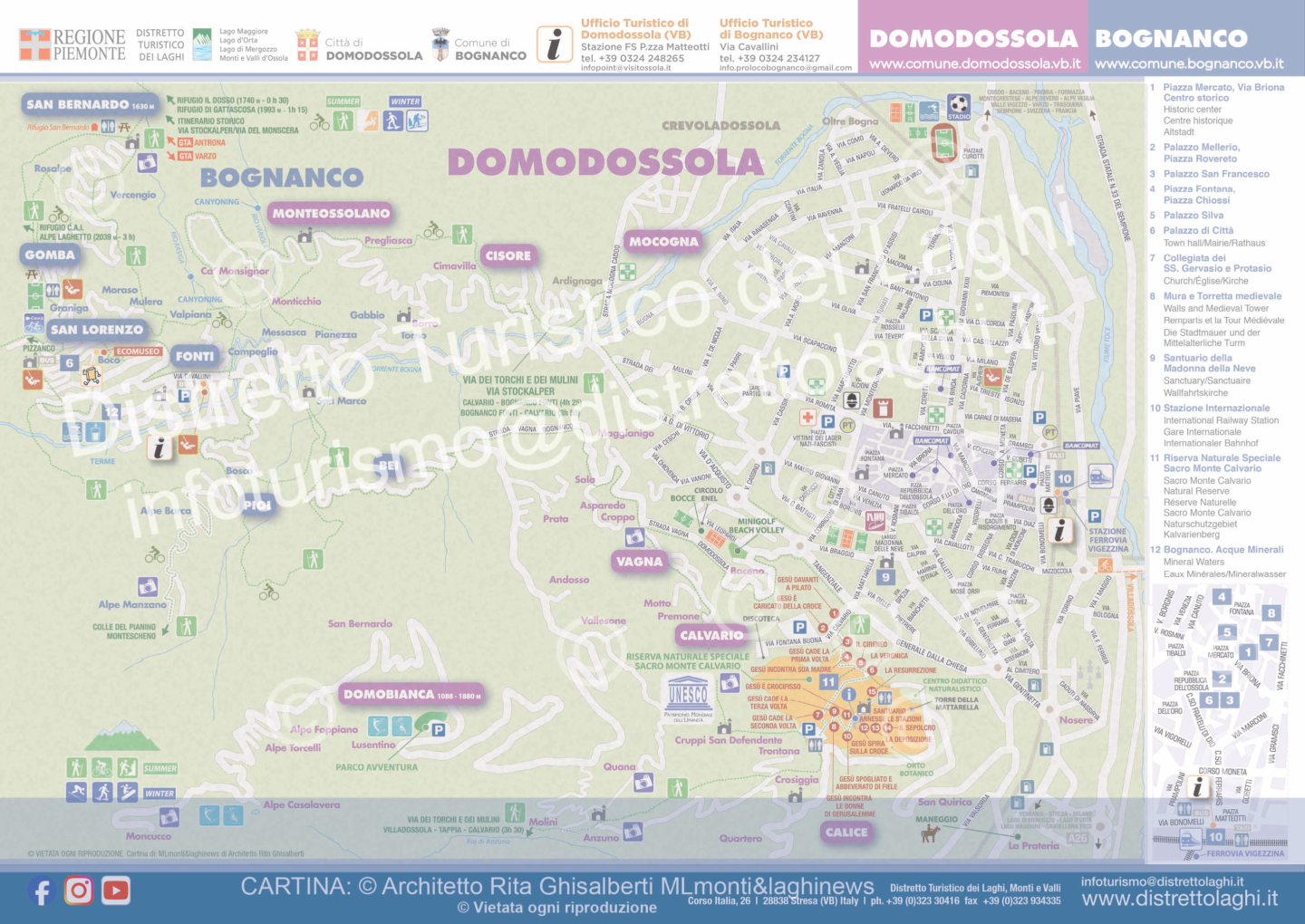Domodossola - Small town of excellence
Recognitions
Cultural Village
Altitude
272 a.s.l.
Patron Saint
19 June, Saints Gervasio and Protasio
Market Day
Saturday
Tourist Information
www.ilborgodellacultura.it
www.visitossola.it
THE VILLAGE: CHEST OF CULTURE, TRADITIONS AND NATURE
Domodossola, the "Culture Village”, is a pretty town rich in history, art and traditions. It has always been the capital of the Ossola alpine region in the northernmost tip of Piedmont, at the centre of the seven Ossola valleys. Thanks to the presence of the International Railway Station, which leads through the Simplon Tunnel to neighbouring Switzerland (Valais), and the Vigezzina Centovalli Railway, which connects it to Canton Ticino, Domodossola traditionally boasts an important role as a border town, much frequented by Italian and foreign visitors. Lying on the valley floor of the River Toce, its pentagonal historic centre still retains a fascinating medieval flavour. Piazza Mercato, the city's living room in Renaissance style, is characterised by elegant buildings with projecting balconies and loggias, wrought-iron railings, typical roofs with wooden tiles and 15th-century granite porticoes. The square is home to the historic Galletti Theatre and the centre of the most important Domitian events such as the Carnival and the Christmas Markets. Not only that, but it also hosts the great Saturday Market all year round, established by Berengar I in 917 A.D., with colourful stalls selling all kinds of goods. From here you reach the ancient Via Briona, considered the most characteristic street in Domodossola, where you can see the Tower of the ancient Bishop's Palace dating back to 1300, and the squares Rovereto, Fontana, Chiossi and Convenzione, where Palazzo San Francesco stands, a building constructed on the remains of a 13th-century church and now a museum part of the Musei d'Ossola Association. In Piazza Chiossi you can admire Palazzo Silva, built between the 16th and 17th centuries, a rare example of a late Renaissance aristocratic house. The Collegiate Church of Domodossola was built between 1792 and 1797 on the ruins of a 15th-century church and is dedicated to the two Milanese martyrs Gervasio and Protasio, celebrated on 19 June with a large procession. The Giugno Domese (June in Domodossola) is a rich festival with shows, music and other attractions and a large audience that flocks to see performances by nationally renowned artists. At the parish church you can admire the ancient serpentine portal belonging to the previous Romanesque church, the frescoes and decorations by the Vigezzo painter Lorenzo Peretti (1774-1851), the architrave with the relief of Charlemagne and the Chapel of San Carlo Borromeo with the painting by the famous Valsesian painter Tanzio Da Varallo (1615). In the 14th century, due to the continuous invasions from the Valais, Domodossola was equipped with strong fortified walls that enclosed the entire town and of which only small traces remain today: the Medieval Tower in Via Monte Grappa, the section of wall in Via Facchinetti and the corner tower in Via Canuto. Not to be missed is a visit to the Special Nature Reserve of Sacro Monte Calvario, a UNESCO World Heritage Site, on the panoramic Mattarella Hill, which can be reached from the city centre along the Via Crucis climb. Built from 1656 onwards, it features fifteen chapels with life-size terracotta statues depicting scenes from the Passion of Christ and offers a magnificent view of the city and the surrounding Alps. In 1828, the philosopher clergyman Antonio Rosmini settled there and founded the Institute of Charity, which the Rosminian Fathers still look after today. The Sacro Monte can also be reached from the hamlet of Calice, whose picturesque localities include San Quirico, Crosiggia and Anzuno. The latter is a stop on the "Via dei Torchi e dei Mulini" hiking route, which offers rich evidence of the rural economy of the past. Finally, on the slopes of Moncucco is the ancient hamlet of Vagna, located along the road leading to Lusentino and the Domobianca ski resort.
Typical food and wine
Brisaula Val d'Ossola is a cured meat of excellence in the area, produced in Beura Cardezza, Masera and Crevoladossola along the Toce plain and in the Anzasca, Antrona and Divedro valleys by certified producers members of the association of the same name. It is characterised by the high quality of its meat, which is exceptionally lean, its delicate aroma and its balanced and finely spiced taste. It is precisely the spices and the curing that are the secret of each craftsman to make his own "brisaula" unique in flavour, which also differs in name from its famous Valtellina sister. To enjoy the local charcuterie even more, there are the courageous mountain wines: in the terraced vineyards north of the Piana del Toce, on the slopes of Domodossola, Crevoladossola, Villadossola, Trontano and Crodo, the Valli Ossolane DOC is produced from Nebbiolo, Croatina, Merlot and Chardonnay grapes.
Hospitality
www.distrettolaghi.it/ospitalita
Trekking Routes
Recommended Trekking Routes: THE ANCIENT HAMLETS OF DOMODOSSOLA
Bike Routes
Recommended Bike Routes: "DEL TOCE CYCLE ROUTE, cycling among the rivers", "DEL TOCE CYCLE ROUTE, cycling through the villages" e "Domobianca and Sacro Monte Calvario of Domodossola"
Accessibility
The centre of Domodossola is fully accessible for people with reduced mobility and there are no particular barriers.
Recommended "For all" path: "Ossola valleys: DOMODOSSOLA, VOGOGNA AND SURROUNDINGS"
Handicrafts
Today, Ossola ceramics are a precious testimony to the ancient art originally created in 1808 in the factory of Bartolomeo Toietti, parish priest of Premia in the Antigorio Valley. Until 1862, the clay extracted along the Alfenza river was transported to the Premia kiln and worked there to make everyday items such as jugs, plates and basins. Production was later abandoned until 1978, when the Kamares workshop in Crevoladossola, which bears the "Piemonte Eccellenza Artigiana" (Piedmontese craft excellence) mark, took over the old manual processing techniques and style of intonation. In the atelier in Domodossola you can admire, as in the past, ceramics and objects with abundant flower decorations and classic blue, red and brown ornaments.
Archivio Fotografico Distretto Turistico dei Laghi
Foto di Marco Benedetto Cerini











